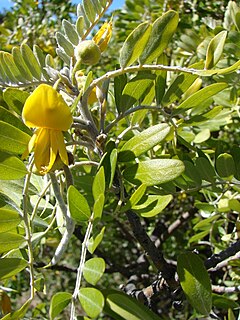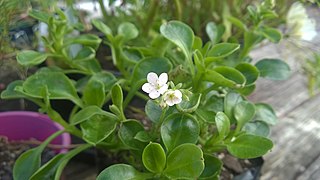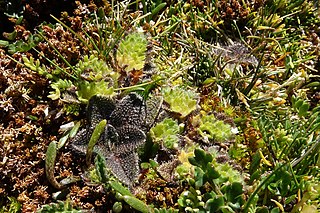
Sophora is a genus of about 45 species of small trees and shrubs in the pea family Fabaceae. The species are native to southern Asia, Australasia, various Pacific islands, western South America, the western United States, Florida and Puerto Rico. The generic name is derived from sophera, an Arabic name for a pea-flowered tree.
Unitec Institute of Technology is the largest institute of technology in Auckland, New Zealand. 16,844 students study programmes from certificate to postgraduate degree level across a range of subjects.

Sir Paul Alfred Reeves, was a New Zealand clergyman and civil servant, serving as Archbishop and Primate of New Zealand from 1980 to 1985 and 15th Governor-General of New Zealand from 20 November 1985 to 20 November 1990. He was the first governor-general of Māori descent. He also served as the third Chancellor of Auckland University of Technology, from 2005 until his death.

Piper excelsum, commonly known as kawakawa, is a small tree of which the subspecies P. excelsum subsp. excelsum is endemic to New Zealand; the subspecies P. e. subsp. psittacorum is found on Lord Howe Island, Norfolk Island and the Kermadec Islands.

Metrosideros bartlettii, also known as Bartlett's rātā, Cape Reinga white rātā or in Māori as rātā moehau, is one of twelve Metrosideros species endemic to New Zealand and is notable for its extreme rarity and its white flowers, somewhat uncommon in that genus of red-flowered trees and plants. Its natural range is in the far north of the North Island at Te Paki, in three patches of dense native forest near Spirits Bay that escaped destruction by fire, namely Radar Bush, Kohuronaki Bush, and Unuwhao Bush. Only 13 adult trees are known to exist in the wild and most of these are either ill or dying. The lack of fossil evidence elsewhere suggests that the tree may always have been restricted to the North Cape area, which was an island until it was connected to the mainland by the sandspit that constitutes Ninety Mile Beach.

Damnamenia is a genus of flowering plants in the family Asteraceae.

Elaeocarpus dentatus, commonly known as hinau, is a native lowland forest tree of New Zealand. Other names in Māori for the tree are hangehange, pōkākā, and whīnau.

Lucy May Cranwell FRSNZ was a New Zealand botanist responsible for groundbreaking work in palynology. Cranwell was appointed curator of botany at Auckland Museum in 1929, when she was 21 years old. As well as her work on ancient pollen samples she was responsible for encouraging a love of botany in a generation of Auckland children.

Harry Howard Barton Allan was a New Zealand teacher, botanist, scientific administrator, and writer. Despite never receiving a formal education in botany, he became an eminent scientist, publishing over 100 scientific papers, three introductory handbooks on New Zealand plants, and completing the first volume of a flora in his lifetime.

Pomaderris apetala is a small tree or large shrub from the family Rhamnaceae, growing in Victoria, New Zealand and Tasmania.

Peter James Bossley is a New Zealand architect based in Auckland, most recognised for his role leading the design team for the Museum of New Zealand Te Papa Tongarewa. Bossley was an adjunct professor at the Unitec Institute of Technology School of Architecture. He has received numerous awards, including the New Zealand Institute of Architects (NZIA) Gold Medal in 2012 for outstanding contributions to the practice of architecture.

Myosotis pansa subsp. pansa, also known as the Waitakere forget-me-not, is a subspecies of forget-me-not endemic to New Zealand.
Lyonel Grant is a New Zealand Māori master carver and sculptor. Born in Rotorua, he affiliates to Ngāti Pikiao and Te Arawa.

Wendy Alison Nelson is a New Zealand marine scientist and world expert in phycology. She is New Zealand's leading authority on seaweeds. Nelson is particularly interested in the biosystematics of seaweeds/macroalgae of New Zealand, with research on floristics, evolution and phylogeny, as well as ecology, and life history studies of marine algae. Recently she has worked on the systematics and biology of red algae including coralline algae, distribution and diversity of seaweeds in harbours and soft sediment habitats, and seaweeds of the Ross Sea and Balleny Islands.

Elizabeth Edgar was a New Zealand botanist, best known for her work in authoring and editing three of the five volumes of the series Flora of New Zealand, which describes and classifies the species of flora of the country. She was most noted for her taxonomic work on the biodiversity of New Zealand and was recognised as the foremost authority on nomenclature and description of the country's plants.

Dracophyllum arboreum, commonly known as Chatham Island grass tree and tarahinau (Moriori), is a species of tree in the heath family Ericaceae. Endemic to the Chatham Islands of New Zealand, it reaches a height of 18 m (60 ft) and has leaves that differ between the juvenile and adult forms.

Sculpture on the Gulf is a temporary outdoor art exhibition on a coastal headland on Matiatia Bay, Waiheke Island, New Zealand. It is a biennial event founded in 2003 by the Waiheke Community Art Gallery.

David John Galloway, FRSNZ was a biochemist, botanist, and lichenologist.

Myosotis antarcticasubsp. antarctica is a subspecies of flowering plant in the family Boraginaceae, native to New Zealand, Campbell Island, and southern Chile. Joseph Dalton Hooker described the species in his 19th century work Flora Antarctica. Plants of this subspecies of forget-me-not are perennial with a prostrate habit, bracteate inflorescences, and white or blue corollas. It is one of two native Myosotis in the New Zealand subantarctic islands, the other being M. capitata, which also has blue corollas.

Myosotis goyeniisubsp. goyenii is a subspecies of flowering plant in the family Boraginaceae, endemic to southern South Island of New Zealand. Donald Petrie described the species M. goyenii in 1891. Plants of this subspecies of forget-me-not are perennial rosettes which form loose clumps, with ebracteate, erect inflorescences, and white corollas with partly exserted stamens.

















